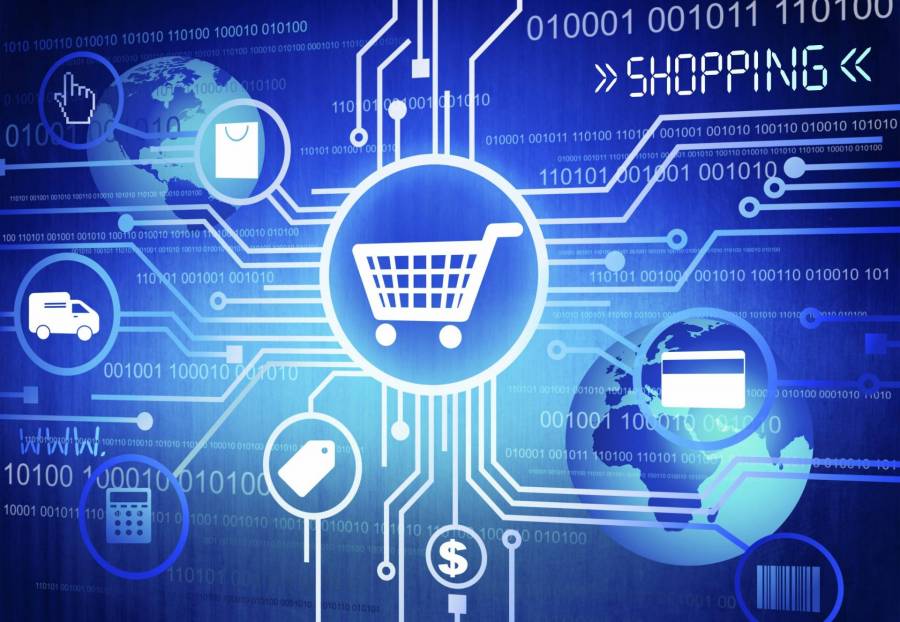With the developments in the internet, eCommerce and the way we sell goods and services online are changing at all times. Merchants and retailers are investing in eCommerce website development to boost their sales with no geographical barriers. While being familiar with terms like PPC and CPC, and other key performance indicators can let you know where and how your products should be sold online, understanding the fundamentals of eCommerce is important. Here’s a detailed guide on the evolution of eCommerce – a glimpse of its past, present, and future that can help you learn how to sell products and services to your online consumers more efficiently.
Take a Look at the History of Ecommerce
Michael Aldrich, an English inventor, is the pioneer of electronic shopping or eCommerce. Aldrich’s system coupled a reformed domestic TV to a simultaneous payment processing computer through a domestic telephone line. This made the private information system open and shareable for external parties, thus, leading to the introduction of modern eCommerce.
Since then, there was no turning back. The occurrence of significant events has made eCommerce what you see today. In 1994, Amazon was launched as an eCommerce platform for selling books online. Eventually, Jeff Bezos transformed the website into one of the largest eCommerce platforms for all types of products.
PayPal also entered into the eCommerce industry as a quick money transfer solution for merchants. When PayPal united with the internet banking firm of Elon Musk, it experienced immense popularity as a token eCommerce buying platform.
Furthermore, Google AdWords was introduced for eCommerce development companies as well as merchants to help them optimize ads for consumers using Google Search. Subsequently, eCommerce businesses started using this tool for running PPC campaigns.
Several other platforms like Etsy, BigCommerce, Shopify, WooCommerce were introduced that broadened the eCommerce market and create new opportunities for retailers to sell products online.
Now that we’ve discussed the history of eCommerce, let’s move ahead to the present of eCommerce and see what current trends are.
What’s the Current Status of Ecommerce?
-
The Global COVID-19 Pandemic
The outbreak of COVID-19 pandemic has confined many people within the four walls of their homes and shifted regular purchases such as grocery, food, apparel, and entertainment online. This has led to the emergence of many new eCommerce stores which increased the demand for eCommerce website development services.
Due to this drastic shift, customers spent 791.70 billion US dollars eCommerce businesses in 2020, up 32.4% from 598.02 billion US dollars in the past year, as reported by Digital Commerce 360. The global pandemic has not only changed the consumer buying habits but also transformed eCommerce and the way retailers used to sell products and/or services.
-
Integration of Artificial Intelligence Tools
With the inception of Artificial Intelligence in the eCommerce world, online retailers have been able to increase business efficiency and reach out to more customers effectively. AI in eCommerce is becoming increasingly popular worldwide. According to a survey conducted by Tractica, it is estimated to be worth $36.7 billion globally by 2025.
Google searches and Amazon Alexa shopping have made voice assistants an integral part of eCommerce. They allow users to perform product search and communicate with web services through voice commands. Moreover, the technology can seamlessly integrate into smartphones or smart speakers exclusively designed for voice-based interaction.
Furthermore, chatbot in eCommerce helps customers in making purchase decisions. Chatbots usually communicate with the customer, addressing the common queries via text messages or phone calls. Chatbot integration in eCommerce websites helps businesses to provide assistance to customers 24×7 round the clock.
-
Subscription-based Business Model
The subscription-based business model is the new trend, greatly used by companies like Netflix, Spotify, etc. Nearly 50% of all online customers have a subscription, and 15% of those are subscription for tangible products. Customers who own a subscription enjoy free or discounted shipping, store credits, discount offers on specific products, and special occasion benefits.
Amazon Prime is one of the most popular subscription models. Its membership grew to 200 million members in June 2021.
Future Ecommerce Website Development Trends
B2B eCommerce sales is predicted to reach almost $1.5 billion in 2021, which 12.2% more from 2012, as eCommerce trends continue to impact the daily operations of B2B firms. In the coming year, eCommerce will experience changes and trends that are going to be very different from the ones in the past.
-
Green Consumerism
Since eCommerce is booming rapidly, there is a need for a sustainable and eco-conscious option. Customers prefer products that are environment-friendly. According to GWI, 60% of online consumers say that they are willing to pay more for eco-friendly products. It’s good to see that consumers are becoming more eco-conscious.
2. AI-Based Shopping
AI in eCommerce is another popular trend that is revolutionizing the industry. The use of artificial intelligence in eCommerce leads to a more enhanced user experience through personalized shopping experiences. Ecommerce businesses can use collected and processed data to provide personalized recommendations to their customers in real-time and create a more tailored buying experience. AI-based customer journeys create a personalized experiences tailored to the needs and interests of every customer.
3. Voice Search
In today’s digital age, we have numerous virtual assistant like the very famous ones Google Voice Search, Google Home, Amazon Alexa, Siri, Cortana, and Viv. These virtual assistants enable consumers to use voice commands for searching on major search engines. Voice search is gradually emerging as a trend for eCommerce businesses. According to Google, over 20% of mobile device queries are voice-based. Also, more than 40% of millenarians use a voice assistant to perform searches.
Ecommerce development companies should consider integrating voice search technology to ensure customers’ loyalty. The implementation of AI can help in understanding the search query and catering to the users with relevant answers or results.
4. Growth of E-Commerce
As shoppers are using mobile devices for online shopping, it has led to the rise in M-Commerce. Customers are shopping through social media platforms like Facebook, Twitter, Pinterest, etc. as these platforms have added “Buy Buttons” to help them buy products/services without leaving the site. Moreover, the one-click option helps customers to make purchases without re-entering the payment details by storing their card info once.
5. Mobile Wallet and Mobile Applications
Only creating a mobile-friendly eCommerce websites is not enough. You need to integrate mobile wallet for payment into your website. Not only this, you should also consider building a user-friendly mobile application for your retail business. As the number of online consumers is increasing day by day, they shoppers understand the advantages and prefer to use secure mobile wallets for the payment. So, integrating a mobile wallet into your business website will help you boost your sales.
Many online customers prefer to use mobile apps for making purchases as they are more convenient, and user-friendly.
6. Rise in ROPO/ROBO
Research Online, Purchase Offline (ROPO) or Research Online, Buy Offline (ROBO) is another significant eCommerce trend that has become increasingly popular in the past few years. However, it cannot be considered as the evolution of eCommerce world. It can be seen as pinnacle of eCommerce technologies of the past decade.
ROBO or ROPO allows customers to search for products and/or services easily and at the best market price. ROPO helps online retailers to keep track of their offline sales conversions. As an eCommerce business owner, you need to make your digital marketing strategies focused around the ROBO approach. With the support of several metrics and CRMs, customer purchase history, mobile payment, and social media integration, you can efficiently meet the needs of ROBO customers.
Whether you’ve invested in WooCommerce website development, or in Magento eCommerce development, or working with Prestashop developers, incorporating the trend of ROBO/ROPO can help you retain your customers and boost sales with enhanced shopping experience.
7. Product Customization
The demand for product customization is increasing in the eCommerce world. It is also one of the emerging technology trends for online merchants. As product customization feature makes customers’ purchases easy and convenient, it can eliminate the complications of online purchases and meet the requirements of today’s customers.
Automation is also playing a vital role in the product/service customization. For example, YouTube offers recommendations of videos based on the user behavior. The service gets tailored based on the customers’ usage patterns.
Many businesses worldwide are using this process. From the choice of clothes to entertainment to furnishing, product customization has emerged as the new eCommerce trend. Companies are customizing the products and services to make their customers’ purchase easier and more convenient
8. Omnichannel Strategy
Direct-to-Customer brands are redefining customer’s journey by improving engagement and interaction via multiple touchpoints across various marketing channels such as websites, apps, mobile, social media, and even physical stores simultaneously.
Companies are now able to monitor the onsite and cross-channel user behavior and utilize this valuable insight to cross-sell business products through their inventory. In D2C model, consumers are interacting with brands on different platforms, touchpoints, and channels. Implementing an omnichannel strategy helps brands to track customers’ behavior across multiple channels and platforms. This further helps them to understand their demographics, pages browsed, how long they stay on each page, products or product categories viewed, and so on to gain a better idea about a customer’s purchase behaviors and intent. This information can be used to offer relevant product recommendations to buyers to upsell and cross-sell, thereby boosting the Average Order Value (AOV) for each customer.
9. Social Commerce
Social commerce is another eCommerce trend that is becoming popular among customers and brands as it connects them on a single platform. This enables them to engage in meaningful ways and allows customers to discover more and shop seamlessly.
One of the most effective ways businesses are converting loyal followers to paying customers is through social proof, which involves influencer marketing, reviews, and endorsements. To create a seamless shopping experience with fewer clicks, businesses are making quick payments the essential part of the mobile-first shopping experience.
10. Video Marketing
Unlike other forms of content marketing, videos prove to be an effective marketing strategy for promoting your products and attracting new consumers. You can create and place video content on the key areas of your eCommerce website like your homepage, about us page, product pages, etc. as well as on your social media accounts. Unboxing videos, explainers, tutorials, and user-generated content can make your customers understand your offerings and help them make purchase decisions.
11. Augmented Reality and New Technologies
In 2022, eCommerce businesses will continue to incorporate new technologies to stay ahead in the market competition. Innovative features like product builders, product visualizers, 3D mapping, and augmented reality help online customers to explore, visualize, and test out products before buying. This prominent product merchandising allows you to recreate in-store experience that many customers crave while offering them an engaging shopping experience.
12. Customer Journey Optimization
With the rise in eCommerce website development, eCommerce has emerged as the main customer purchase path for businesses. Therefore, sellers must track and improve every customer touchpoint to stay competitive. For customer journey optimization, you need to focus on improving your product search, building a smooth mobile-first shopping experience, providing product merchandising, and improving your order fulfillment and return processes.
13. Conversion Rate Optimization
To run a successful eCommerce business, you must try to grab the attention of buyers from the get-go and eliminate any hurdle in the conversion path. Conversion rate optimization is one of the crucial parts of eCommerce website development and an evergreen eCommerce trend that will help retailers achieve both short-term and long-term outcomes.
14. Leveraging Marketplaces and New Channels for Sales
Customers often flock to online marketplaces like Amazon, Walmart, industry-specific and curated websites. This indicates a shift in purchasing preferences toward speed and convenience that can be provided by these large marketplaces. So, instead of focusing on sales through your eCommerce website only, you can sell products on Amazon to leverage its wide customer reach and efficient services while maintaining the control and brand experience of your official website.
15. B2B Ecommerce Trends
B2B eCommerce has been facing significant changes over time. Today, paper catalogs and complex phone orders are being replaced by completely digitalized self-service shopping experiences, better customer service, and smooth back-end processes. B2B companies are considering updating their eCommerce platforms and benefitting from the latest eCommerce trends for 2022 and beyond.
As a B2B business, you will need to create digital catalogs, offer B2C-like shopping experiences, and fulfill orders quickly and efficiently to remain competitive. Implementing effective B2B eCommerce strategy can help in boosting sales, increase average order value, and achieve greater customer satisfaction.
16. International Ecommerce
International eCommerce involves selling products/services online to customers who live in foreign countries. In fact, there’s no boundary to where you can expand your eCommerce business if there is a good market for your products and/or services. However, any business expansion into a new market needs a lot of resources, time, and effort.
Both physical and online stores can explore new audiences by incorporating international eCommerce into their business strategy. With an integrated eCommerce solution, businesses can enjoy various benefits such as increased brand visibility and a large customer base.
17. Multiple Payment Options
Today’s online customers want the freedom to select their preferred payment option during the checkout process. Ecommerce websites that use diverse payment methods are more likely to build trust, retain more customers, lower cart abandonment rates, and encourage shoppers to purchase more.
No-interest financing options like ‘buy now pay later’ and fast one-click payment method are likely to become more popular and will be preferred by customers for flexibility with their online shopping.
18. Purpose-driven Shopping
Shopping with purposes is one of the emerging eCommerce trends for any mission-led brands. Due to the effects of pandemic, there was a real upward shift in the conscious customer spending index, as people were looking for multiple ways to help people in need.
The rising influence of important social causes has led customers to shop with a purpose, looking to support communities through their purchases or contributions.
Be careful about the consequences of inauthentic cause marketing. You must incorporate this trend ethically to support your brand.
19. Focus on Customer Data Privacy
Customer data privacy is one of the significant eCommerce trends. Customers are becoming aware of the how brand use their data and their demand for more permission control is being recognized finally. This has led to enhanced user experience around direct control of permissions. Third-party cookies are also getting obsolete now.
All these changes are going to affect companies that depend on digital marketing. However, you must remember that these challenges are the consequences of consumer demand. So, instead of perceiving increased restrictions around data privacy and control as a problem, rethink it as an opportunity to exhibit brand values through ethical and proper data handling.
Also, try to focus on ensuring 100% transparency. Tell your users that you are interested in knowing more about them to help them enjoy a useful and personalized experience. In the coming years, zero-party data will be increasingly appreciated, so start planning for its creative collection in 2022.
20. The Importance of Authentic Content
Brands are going to accelerate the pace of content creation in 2022. Consumers are looking to engage with brands beyond their products, and content is the most effective way to connect and interact in this manner.
You need to demonstrate legitimacy with your content marketing efforts to stand out and enjoy the benefits. If you’re a specialist brand, then you can use this opportunity to show your expertise.
Mission-led brands can use this trend to narrate the story of their purpose and share the impact you are having on social causes and communities.
21. The Use of Big Data and Analytics in Ecommerce
The implementation of Big Data and analytics is helping eCommerce business owners stay ahead in the market competition. Big Data is a huge collection of data that companies can use to figure out which product or service, price, and advertising is best to increase their business profits. Ecommerce analytics involves the process of collecting useful data from multiple channels that impact your eCommerce store. You can even use this valuable data to understand shifts in user behavior and online shopping trends.
Big data resources help in optimizing logistics, supply chain management, inventory, and business operations. This results in enhanced performance and significant cost reductions.
Some of the key sources of big data include competitor offers, product cost, stock level, sales data, customer data, and all aspects of advertising. They are available in various forms and demand different approach to utilization by eCommerce business websites.
22. Ecommerce Dropshipping
Dropshipping is a kind of retail fulfillment approach where the store or the seller can sell products without keeping them in stock. So, as a seller, you can showcase and sell items from your website without essentially having them in stock.
There are several advantages of dropshipping business model such as zero upfront inventory cost, no stress of handling logistics, and freedom to operate from anywhere.
The idea of implementing an eCommerce dropshipping business model sounds exciting. However, it involves a lot of hardwork, time, and ability to handle long-term relationships with customers and suppliers. With the support of one of the professional eCommerce development companies, dropshipping can be a great opportunity to build your online business with low maintenance and higher scalability.
Ready to Transform Your Business with These Ecommerce Trends?
Over the years, eCommerce industry has gone through different phases, facing various ups-and-downs in the global market. Many more powerful technologies are yet to come in the coming years and disrupt the eCommerce industry. Mobile platforms will continue to be a part of eCommerce business and subscription of products/services will become important in the digital market. There will be a great revolution in the way of online marketing and product showcase.
You need to make sure that your eCommerce store is prepared for future by incorporating these eCommerce trends within it. In case your store lacks any feature, you should quickly adopt one to stand out from the crowd. Get professional and reliable support of eCommerce website development company in this regard if you are ready to transform your eCommerce business with the latest eCommerce trends for 2022.


















